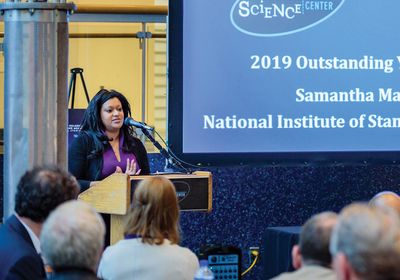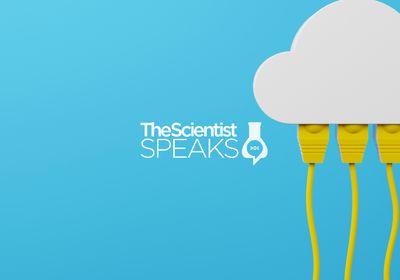ABOVE: Samantha Maragh received the State of Maryland Outstanding Young Scientist Award 2019 for establishing the NIST Genome Editing Consortium. Scott Marder, Maryland Science Center
When Samantha Maragh, who now leads the Genome Editing Program at the National Institute for Standards and Technology (NIST), was in elementary school, she loved watching the Forensic Files documentary series on television with her father. Watching scientists, especially women, perform remarkable DNA analysis experiments to solve criminal cases was her first exposure to the profession. Maragh was inspired; the show sparked an early aspiration to become a scientist as an adult. “It’s a TV show, but it was really impactful to me,” Maragh recalled.
Maragh grew up in Baltimore, Maryland, as a first-generation American to immigrant parents. Her parents, having moved from Jamaica to ensure opportunities for their children, prioritized her education throughout her school years. Maragh maintained a healthy interest in biology all those years, but when she took her first genetics course in her undergraduate studies at Loyola University, she knew instantly that she had found her calling. “As, Gs, Cs, and Ts and combining things together doesn’t make any logical sense, but it completely resonated with me, like I had found my science home,” she reminisced.
Despite her desire to keep learning, Maragh did not pursue a master’s degree right away following graduation. Instead, she planned to first secure a job and then ask her employers to fund her continued education. Even though her friends were skeptical, Maragh remained hopeful. As luck would have it, Maragh secured a position as a technician at the NIST in May 2006. This job shaped the course of her career path.
A tryst with NIST
NIST is a nonregulatory federal agency under the US Department of Commerce. Set up in 1901, the organization sets standards for measurements for just about everything from atomic clocks to electrical outlets. While the NIST organization integrated physics, chemistry, and engineering into its working groups early on, the institution formulated biology specific divisions relatively recently in the 1990s.
Maragh snagged a role at the Biochemical Sciences Division but knew nothing about NIST when she applied. However, she soon realized the value of the work done at the institute.
One of NIST’s projects involved standardizing the short tandem repeat (STR) DNA analysis method used in forensics for reliably identifying an individual.1 Maragh recalled the surreal feeling when she realized that her workplace was integrally connected to the forensic science that inspired her years ago—a rare full circle moment.
Maragh first worked on a collaborative project between NCI and NIST to study cancer biomarkers for early detection. Researchers reported new cancer biomarkers frequently, and yet the subsequent experiments with these markers weren’t panning out for some reason. Maragh took up the task of developing positive controls to ensure consistency and efficiency of assays, specifically sequencing-based ones for identifying mitochondrial DNA mutations, used across different research groups.2
“She was just learning and growing at such a rapid pace and had become a real thought leader,” recalled Laurie Locascio, who led Maragh’s division and oversaw the NCI collaboration projects at the time. Locascio is currently the director of NIST and the undersecretary of Commerce for Standards and Technology. “It was clear that she would be tremendously successful,” she added.
Impressed by Maragh’s work excellence, her bosses at NIST supported her in taking night courses for continued education, and Maragh obtained her master’s degree in biotechnology from John Hopkins University in May 2008. However, Locascio and a few other NIST leaders had even bigger plans for her.
Locascio felt that an advanced degree and exposure to life outside of NIST would enhance Maragh’s career options. Locascio’s boss back then, Willie May, agreed. May tapped her on the shoulder one day and said that she should pursue a PhD degree. Maragh could choose any competency for her graduate studies as long as she could apply that knowledge at NIST once she graduated.
Three months after completing her master’s degree, Maragh enrolled in the human genetics PhD program at John Hopkins University, manifesting the master plan that she had conjured up as a student.
Crispier than CRISPR
During her graduate program, Maragh studied gene function in early cardiac development in zebrafish. She routinely knocked down protein expression using morpholinos, which are oligonucleotides that bind to mRNA and obstruct translation. Since knockdowns don’t guarantee complete protein inhibition, Maragh wanted to validate her results by suppressing protein expression at a genetic level.
She first attempted to use the zinc finger nuclease (ZFN) system for genome editing but found it challenging. She then tried to knock out her desired gene using transcription activator-like effector nucleases (TALEN), a new genome editing tool at the time with growing popularity.3 Using TALEN, Maragh replicated the phenotype she had observed with RNA knockdown.
Around that time, she heard about a new study where researchers had leveraged clustered regularly interspaced palindromic repeats (CRISPR) and an associated nuclease, which function as a natural immunity mechanism in bacteria, to create a programmable machinery to edit cells.4 Although Maragh did not get the chance to test the CRISPR system in the lab, she realized the power the flexible technology offered right away, especially having worked with the relatively more complicated ZFN and TALEN tools. As the list of CRISPR applications grew with researchers globally adopting the technique, she also saw the risk for inconsistencies and raised questions that not many were thinking about at the time.
“What in the world are we doing to the genome? And how do we know what we are doing?” she recalled wondering. “My NIST brain went ‘controls, variability.’”
When Maragh returned to NIST, she had the opportunity to propose a promising topic area that wasn’t on the organization’s radar at the time. She right away thought of CRISPR. “This is a totally new world and there’s a place for NIST here,” she thought.
When she pitched her idea at her division’s proposal meeting to solicit peer feedback, a colleague asked, “Is there going to be something crispier than CRISPR one day?” That got her thinking. CRISPR was a promising tool, but ZFN and TALEN remained important players in the field. And given the rapid scientific advances in CRISPR-related technologies, it seemed likely that newer tools were on the horizon.
Maragh broadened her scope to genome editing, successfully convinced her colleagues about the promising outlook of this area, and eventually started the Genome Editing Program at NIST in 2016. The program aims to apply the NIST lens of standards to genome editing research to ensure that scientists use consistent methodology, controls, data formats, and terminology to minimize variability in experiments.
The first task for Maragh’s program team was to engage with the genome engineering community and demonstrate that NIST’s goals aligned with their needs. Around this time, Maragh serendipitously came across a short commentary written by an academic about the need for standards in CRISPR research.5 She knew right away that she had found a potential ally: Keith Joung, a genome editing pioneer and group leader at Massachusetts General Hospital.
A consortium is born
Joung has been strategizing genome and epigenome editing technologies that could improve human health for almost 20 years. With the rapid growth in the sector at the time, Joung worried about experimental technique variability between groups. He saw a need for standardizing definitions and practices to establish a baseline for the researchers working in this emerging area. “When I heard about NIST and their mission and Samantha’s interest in having NIST take a role in doing this, I thought, yes, that would be fantastic,” he said.
When I heard about NIST and their mission and Samantha's interest in having NIST take a role in doing this, I thought, yes, that would be fantastic.
—Keith Joung, Massachusetts General Hospital
With Joung’s support, Maragh conducted her first workshop at the American Society of Gene and Cell Therapy Conference in 2016. Representatives from across the biotechnology sector, academia, pharmaceutical companies, and nonprofit organizations attended. Maragh sourced feedback regarding their challenges and interrogated where they needed data validation tools.
“I heard a lot of positivity there. One organization was like, ‘You know, I can see their building, but I can’t go talk to them because of noncompete sort of things, and I need a mechanism that would allow us to be under the same umbrella,’” Maragh recalled.
Maragh thought that a consortium would be the perfect solution. However, on soliciting further feedback, she realized that the genome editing community needed more than just a forum that convened to exchange ideas. They sought NIST’s support in making samples and executing experiments.
When Maragh realized that this meant that NIST would almost function as their research arm, she worried about how she would find resources for these unconventional requirements.
Determined to find a creative solution, Maragh conceptualized a new cost-sharing consortium model where every member contributed in some way. “If you are a sequencing company, maybe you can sequence. If you are a reagent maker, maybe you can provide reagents. If you are an engineering company, maybe you can support with some cell engineering, and if you are big pharma, maybe you just give money,” she explained. “It was very different for NIST. There was no such model; it took me a while. I had to create the model.”
After months of grueling paperwork, Maragh officially launched the Genome Editing Consortium in October 2018 with 20 members from diverse institutions. The consortium comprised three working groups. The “specificity measurements” group worked on the reproducibility of on-target and off-target assays and related controls. The “data and metadata” group covered bioinformatics related topics such as evaluating different tools or generating high quality data sets that researchers could use as positive controls. Lastly, the “lexicon” team standardized the genome editing vocabulary. Members could join one or more groups based on their needs, and each group met monthly.
Bringing together a disparate group of people who have different interests in working together is not an easy task, commended Joung. “I think she’s done a great job of that.”
Locascio seconds that opinion. “I really give great credit to her for thinking about this and what was a very nascent field and building this consortium around what could be the difficulties in getting this implemented in the real world,” she said.
The consortium has made big strides in several projects over the past few years. Maragh is particularly proud of completing the first version of a genome editing vocabulary standard that includes definitions of key terms used in the field. The team worked hard on curating the relevant terms, drafting the concise definitions, getting experts to review them, and finally seeking global feedback. After a regimented and rigorous review process, Maragh was thrilled when the document was finally approved by the International Standards Organization and published on their site.
For her success in building the NIST Genome Editing Consortium as a public-private partnership, Maragh received the George A. Uriano Award in 2021.
Staying on target and under control
Today, the genome editing consortium has grown to more than 40 members, and all three groups are still active. Joung enjoys watching Maragh in action bringing members with diverse interests to work together. “The advances come so quickly that to some degree, you have to be nimble and adjust or expand your expectations as far as the field’s,” he said. “I’m grateful that somebody like her is willing to undertake this type of effort.”

For instance, within just a few years after CRISPR being adopted in labs worldwide, the genome editing community welcomed new tools such as base editors and prime editors. So, the standardized lexicon document lacks the definitions for these technologies, which didn’t exist at the time of its creation, but are now crucial to the field. Maragh hopes that her teams will add suggested definitions for some of the missing terms to the glossary at some point.
In fact, there is a long wishlist of goals she would like to accomplish in the near future. In one project, her team intends to generate some physical samples of engineered cells bearing arrays of edits for consortium members to use as positive controls for complex edits.
Maragh spoke of another interesting consortium project that is currently underway. This Genome in a Bottle (GIAB) project is a blind inter-lab study to assess the accuracy of capabilities that consortium members are currently using for detecting DNA variants. The NIST team sent consortium researchers a mixture of cells or DNA with varying sizes and frequencies of mutations at different loci. The researchers will use the technology of their choice and expertise, such as sequencing, genome wide DNA imaging, and fragment analysis, and report back the variant size and frequency data. On comparing data from different research groups, Maragh hopes that the NIST team can zero in on the most accurate capabilities that will serve as the gold standard for detecting DNA variants moving forward.
“The goal of setting standards for how things are measured in our field remains a very, very important one. And so, I would like to see them be a bit more vocal and proactive in trying to put these standards out there and trying to get people in the field to follow them,” Joung suggested.
In addition to leading the Genome Editing Program, Maragh now comanages NIST’s Cancer Biomarker and Genomic Science Group, which includes programs on genome editing, cancer biomarkers, flow cytometry, and human genome sequencing. Although she does not have a master plan for the future anymore, she wants to continue working in the regenerative medicine and precision medicine application areas.
“She is clearly a scientific leader, and now she leads an external facing consortium, but I definitely see her growing into larger roles and moving up the organization,” said Locascio. “She just has very unique characteristics that make her a natural leader.”
References
- Ruitberg CM, Reeder DJ, Butler JM. STRBase: a short tandem repeat DNA database for the human identity testing community. Nucleic Acids Res. 2001;29(1):320-322.
- Jakupciak J, et al. Analysis of potential cancer biomarkers in mitochondrial DNA. Curr Opin Mol Ther. 2006;8(4):345-354. Accessed August 1, 2023.
- Joung JK, Sander JD. TALENs: a widely applicable technology for targeted genome editing. Nat Rev Mol Cell Biol. 2013;14(1):49-55.
- Jinek M, et al. A programmable dual-RNA-guided DNA endonuclease in adaptive bacterial immunity. Science. 2012;337(6096):816-821.
- Joung J. Standards needed for gene-editing errors. Nature. 2015;523:158





